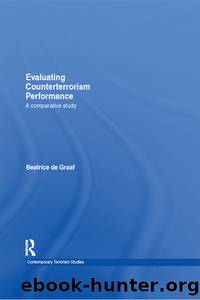Evaluating Counterterrorism Performance by Beatrice de Graaf

Author:Beatrice de Graaf [Graaf, Beatrice de]
Language: eng
Format: epub
Tags: History, Military, General, Political Science, Security (National & International), Law Enforcement, Terrorism
ISBN: 9781136806551
Google: we6rAgAAQBAJ
Publisher: Routledge
Published: 2011-03-15T15:53:41+00:00
7.3.7 Inflammatory use of antiterror units and shootouts
On 26 September 1972, in response to the failed Palestinian hostage action during the Munich Olympics, a special antiterror unit was formed as part of the West German military police (the Grenzschutz, later Bundespolizei), the so-called Grenzschutztruppe 9 (GSG-9). Like their Dutch colleagues, they only received a handful of opportunities to display their qualities. Their chief feat was âOperation Feuerzauberâ in 1977: successfully storming the passenger aeroplane Landshut that had been hijacked by Palestinian PFLP terrorists in support of Hanns-Martin Schleyer's kidnappers. On the night of 18 October of that year, the GSG-9 succeeded in clearing the plane, killing âbutâ three of four hijackers, while all passengers survived. This operation gave GSG-9 instant world fame.111
Neither in the Netherlands nor in West Germany were militarily equipped commandos deployed frequently, which was considerably demoralizing to the officers and men: they were forced to face endless practice routines, without being able to field test their skills. This resulted in a substantial number of personnel leaving the units.112 Further, the police services generally preferred to handle the jobs themselves. In both countries, the constabulariesâ regional autonomy could only be counter-balanced by means of national instructions provided by the justice or interior ministries. Politicians were however very reluctant to do so, a reserve that, particularly in West Germany, was not only prompted by constitutional restrictions, but also by historic experience.
In the United States, where special units were deployed alongside local police forces far more often, this cooperation was less problematic. The jurisdiction of law enforcement bodies was not decentralized, as in the Netherlands, but divided according to the nature of the offence. Where âfederal crimesâ were concerned, national law enforcement agencies â the FBI in particular â always came into the picture. Further, local police services frequently requested this type of assistance, as detaining notorious criminals or âterroristsâ often led to violent shootouts. In all other cases, regional and local forces could act autonomously.
Around 1969, America experienced a wave of police killings. According to FBI statistics, 86 police officers were shot dead âin the line of dutyâ in that year, 100 in 1970 and by June 1971 the number of deaths of that particular year was already 50. These deaths were explicitly considered a problem of political and extremist violence:
Certain segments of our nation have chosen to attack all traditional forms of authority. The family structure, colleges and universities, the armed services, all forms of government, and police forces have all been subject to attack. What began largely as a verbal attack on these forms of authority has escalated in some instances to senseless physical violence. . . . Attacks on law enforcement officers, particularly by extremist elements on both sides of the spectrum, are becoming a problem of alarming proportions.
In that context, the International Association of Chiefs of Police even wondered whether they were dealing with a ânational conspiracy to kill policeâ,113 a suspicion that was widely discussed in the media (âPanthers, Weathermen Plot to Kill Copsâ).114
The
Download
This site does not store any files on its server. We only index and link to content provided by other sites. Please contact the content providers to delete copyright contents if any and email us, we'll remove relevant links or contents immediately.
The Borden Murders by Sarah Miller(4278)
The Secret Barrister by The Secret Barrister(3664)
Police Exams Prep 2018-2019 by Kaplan Test Prep(2517)
Coroner's Journal by Louis Cataldie(2459)
The Splendid and the Vile by Erik Larson(2419)
Terrorist Cop by Mordecai Dzikansky & ROBERT SLATER(2053)
My Dark Places by James Ellroy(1914)
A Colony in a Nation by Chris Hayes(1905)
The Art of Flight by unknow(1843)
Black Klansman by Ron Stallworth(1768)
Objection! by Nancy Grace(1765)
A Life of Crime by Harry Ognall(1713)
The New Jim Crow by Michelle Alexander(1677)
American Prison by Shane Bauer(1645)
Anatomy of Injustice by Raymond Bonner(1643)
Invisible Women by Caroline Criado Perez;(1607)
Whoever Fights Monsters by Robert K. Ressler(1594)
Obsession (The Volkov Mafia Series Book 1) by S.E Foster(1560)
A is for Arsenic: The Poisons of Agatha Christie (Bloomsbury Sigma) by Kathryn Harkup(1527)
